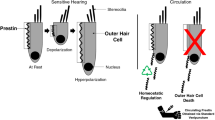Abstract
Purpose
The blood group can have an effect on the auditory system, and it is suggested that it could be an indicator of noise-induced hearing loss. There could be changes in the immittance findings, too, in adults having different blood groups. The present study attempted to determine if there are any differences in tympanometric results (admittance, peak pressure, gradient, resonance frequency, and ear canal volume) and acoustic reflex thresholds (ART) at 500, 1000, 2000 and 4000 Hz between individuals with different blood groups (A positive, B positive, O positive and AB positive).
Methods
Eighty normal hearing adults between the age of 18 and 27 years were considered for the study. They were divided into 20 participants, each with blood groups A, B, AB, and O. The immittance findings were recorded from all the participants of the study.
Results
The results showed that the resonance frequency was slightly higher in blood group O compared to other blood groups. Also, the acoustic reflex thresholds were slightly elevated at all frequencies (ipsilateral and contralateral) for individuals with blood group O.
Conclusions
The results of the study suggest possible reduced outer hair cells in persons with blood group O. This could have resulted in elevated acoustic reflex thresholds.


Similar content being viewed by others

References
Plontke S, Zenner HP (2004) Current aspects of hearing loss from occupational and leisure noise. GMS Current Topics in Otorhinolaryngology, Head and Neck Surgery 3
Henderson D, Subramaniam M, Boettcher FA (1993) Individual susceptibility to noise-induced hearing loss: an old topic revisited. Ear Hear 14(3):152–168
Chow KT, McPherson B, Fuente A (2016) Otoacoustic emissions in young adults: effects of blood group. Hear Res 1(333):194–200
Chen WW, Chow KT, McPherson B (2018) ABO blood group and cochlear status: otoacoustic emission markers. Ear Hear 39(3):555–562
Prabhu P, Chandrashekhar A, Cariappa J, Ghosh N (2018) Effect of blood group on ultrahigh frequency auditory sensitivity. Int Arch Otorhinolaryngol 22(04):364–367
Sircar S (2008) Principles of medical physiology. Thieme, Stuttgart, Germany
Edgren G, Hjalgrim H, Rostgaard K, Norda R, Wikman A, Melbye M, Nyrén O (2010) Risk of gastric cancer and peptic ulcers in relation to ABO blood type: a cohort study. Am J Epidemiol 172(11):1280–1285
Kemp DT (2002) Otoacoustic emissions, their origin in cochlear function, and use. Br Med Bull 63(1):223–241
Lonsbury-Martin BL, Martin GK (2007) Distortion-product otoacoustic emissions in populations with normal hearing sensitivity. Otoacoust Emiss Clin App 15:107–130
Anstee DJ (2010) The relationship between blood groups and disease. Blood J Am Soc Hematol 115(23):4635–4643
Koster T, Vandenbroucke JP, Rosendaal FR, Briët E, Blann AD (1995) Role of clotting factor VIII in effect of von Willebrand factor on occurrence of deep-vein thrombosis. Lancet 345(8943):152–155
Chen D, Jia G, Ni Y, Chen Y (2019) Hidden hearing loss: current perspectives and potential therapies. J Bio-X Res 2(2):62–67
Acknowledgements
The authors acknowledge with gratitude Prof. M Pushpavathi, Director, All India Institute of Speech and Hearing, Mysore, for permitting to conduct the study at the institute. The authors also like to acknowledge the participant for co-operation.
Funding
There is no funding by any agency for the manuscript.
Author information
Authors and Affiliations
Contributions
SRS was involved in study design, stimulus preparation, data collection, analysis of the data, interpretation and writing the manuscript; KMV was involved in study design, data collection, analysis of the results and writing the manuscript; NVR was involved in study design, data collection, analysis of the results and writing the manuscript; BN was involved in study design, data collection, analysis of the results and writing the manuscript and PP was involved in study design, data collection, analysis of the results and writing the manuscript.
Corresponding author
Ethics declarations
Conflict of interest
The authors report no conflicts of interest. The authors alone are responsible for the content and writing of the paper.
Ethical approval
The manuscript adheres to the ethical standards according to the Declaration of Helsinki. In the present study, all the testing procedures were carried out on humans using non-invasive techniques, adhering to the guidelines of the Ethics Approval Committee of the institute Ethical approval was obtained from the All India Institute of Speech and Hearing (AIISH) Ethical Review board for carrying out the study.
Informed consent
Informed consent was obtained from the patient to participate in the study.
Additional information
Publisher's Note
Springer Nature remains neutral with regard to jurisdictional claims in published maps and institutional affiliations.
Rights and permissions
About this article
Cite this article
Prabhu, P., Shaji, S.R., Vipinan, K.M. et al. Effect of different blood groups on tympanometric findings and acoustic reflex thresholds. Eur Arch Otorhinolaryngol 277, 3513–3518 (2020). https://doi.org/10.1007/s00405-020-06244-9
Received:
Accepted:
Published:
Issue Date:
DOI: https://doi.org/10.1007/s00405-020-06244-9



